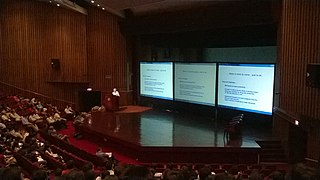
The Indian Institute of Science (IISc) is a public, deemed, research university for higher education and research in science, engineering, design, and management. It is located in the southern Indian city of Bangalore, Karnataka. The institute was established in 1909 with active support from Jamsetji Tata and thus is also locally known as the Tata Institute. It was granted a deemed university status in 1958 and recognized as an Institute of Eminence in 2018.
The Birdwatchers' Field Club of Bangalore is a birdwatching club in Bangalore founded in the 1970s.

Kukkarahalli Lake also called Kukkarhalli Kere, located in the heart of the Mysore city, adjoins the Manasgangotri, the Kalamandir (Rangyana) and the Central Food Technological Research Institute (CFTRI) campus. It provides lung-space to the city. Mummadi Krishnaraja Wodeyar (1794–1868) of the Mysore dynasty was responsible for getting the lake created, in the year 1864, to provide water for irrigation to about 4000 ha of land outside the city. The Lake also used to be a source of water supply to the city of Mysore but over the years, sewage and excessive land encroachments and blockage of water flow sources almost led to the eutrophication of the lake. The University of Mysore and the citizen forums of Mysore continue to make efforts to preserve the lake by implementing several remedial measures. There is a 3.5-km walkway on the periphery of the lake with shaded stone benches for visitors to sit, relax and enjoy the scenic serenity of the lake.

Anurag Kumar was the Director of the Indian Institute of Science at Bangalore, India from 2014–2020. He is a professor at the Department of Electrical Communication Engineering, and has served as the Chairperson of the Electrical Sciences Division at the Indian Institute of Science, before being appointed as the Director in 2014.
Rudra Pratap is an Indian academician and the vice-chancellor of Plaksha University, Mohali. Previously, he was a professor of Mechanical Engineering at the Indian Institute of Science (IISc), Bangalore. Among other research interests, he works in the field of Microelectromechanical systems (MEMS) and used to head India's first research lab in the field of Microelectromechanical systems, the CranesSci MEMS Lab at Indian Institute of Science, Bangalore. His book on MATLAB Getting Started with MATLAB 7 is popular among the students of engineering. He is also the Chair for the Centre of Nanoscience and Engineering (CeNSE).

Education and Research Network (ERNET) is an autonomous scientific society of the Ministry of Electronics and Information Technology, Government of India. ERNET has made a significant contribution to the emergence of networking in the country. It practically brought the Internet to India and has built up national capabilities in the area of net-working, especially in protocol software engineering. It is the first internet service in india. It has not only succeeded in building a large network that provides various facilities to the intellectual segment of Indian society—the research and education community, it has over the years become a trendsetter in the field of networking.
Operand forwarding is an optimization in pipelined CPUs to limit performance deficits which occur due to pipeline stalls. A data hazard can lead to a pipeline stall when the current operation has to wait for the results of an earlier operation which has not yet finished.
Brahm Prakash, was a metallurgist known for his work with nuclear materials in India.

Vijyoshi is an annual national science camp in India organised by KVPY in collaboration with INSPIRE programme, IISc Bangalore and IISER-Kolkata. It is an abbreviation for Vigyan Jyoti Shivir. It started in the year 2009 and is funded by the Department of Science and Technology (India). The aim of Vijyoshi Camp is to provide a forum for interactions between bright young students and leading researchers in various branches of Science and Mathematics.
Gondi Kondaiah Ananthasuresh is an Indian mechanical engineer and Professor at the Department of Mechanical Engineering, Indian Institute of Science, Bengaluru, India. He is best known for his work in the areas of Topology optimization, Compliant mechanism and Micro-Electro-Mechanical Systems (MEMS).
Sandhya Srikant Visweswariah is a scientist and academic at the Indian Institute of Science, Bangalore, India. She is currently the Chairperson of the Department of Molecular Reproduction, Development and Genetics and the Co-chair of the Centre for Biosystems Science and Engineering, Indian Institute of Science. She additionally holds the position of Adjunct Professor, Faculty of Medicine and Dentistry, University of Bergen, Norway. Her research involves the investigation of the mechanism of signal transduction via cyclic nucleotides, phosphodiesterases and novel cyclases in bacteria. Most recently, she was awarded a Bill and Melinda Gates Grand Challenges Explorations Grant for her proposal entitled "A Small Animal Model of ETEC-Mediated Diarrhea".
Rohini Balakrishnan is an Indian bioacoustics expert. She is a senior Professor and Chair of the Centre for Ecological Sciences at the Indian Institute of Science (IISc), Bengaluru. Her research focuses on animal behavior through the lens of animal communication and bioacoustics.
Kanakaraj Sekar is an Indian bioinformatician and a professor at the Department of Computational and Data Sciences of the Indian Institute of Science (IISc). Known for his studies in the field of bioinformatics, Sekar heads the Laboratory for Structural Biology and Bio-computing at IISc. The Department of Biotechnology of the Government of India awarded him the National Bioscience Award for Career Development, one of the highest Indian science awards, for his contributions to biosciences in 2004.
Utpal Shashikant Tatu is an Indian molecular biologist, biochemist, a Professor and Chairman of the Department of Biochemistry at the Indian Institute of Science. He is known for his research on infectious diseases including Malaria, Bebesiosis, Giardiasis, Trypanosomosis, Trichomonosis, Rabies and other neglected tropical diseases of global relevance. He is one of the first proponents of "One Health" concept to control infectious disease outbreaks. The 'One Health' approach advocates designing and implementing strategies, policies and carrying out scientific research which involves collaboration between multiple sectors that will lead to major public health outcomes.Tatu is an elected fellow of the Indian Academy of Sciences. The Department of Biotechnology of the Government of India awarded him the National Bioscience Award for Career Development, one of the highest Indian science awards, for his contributions to biosciences in 2008.
Nagasuma Chandra is an Indian structural biologist, biochemist and a professor at the department of biochemistry of the Indian Institute of Science. She is known for her studies on Mycobacterium tuberculosis. The Department of Biotechnology of the Government of India awarded her the National Bioscience Award for Career Development, one of the highest Indian science awards, for her contributions to biosciences in 2008.
Ashok M. Raichur is an Indian materials scientist, nanotechnologist and a professor at the Department of Materials Engineering of the Indian Institute of Science, Bangalore. Known for his studies on the use of nanotechnology for biomedical and environmental applications, Raichur is a former Alexander von Humboldt Fellow and a life member of the National Academy of Sciences, India. The Department of Biotechnology of the Government of India awarded him the National Bioscience Award for Career Development, one of the highest Indian science awards, for his contributions to biosciences, in 2009.
Patrick D'Silva is an Indian cell biologist, biochemist, and an associate professor at the Molecular Chaperone Lab of the Indian Institute of Science. He is known for his medical discoveries related to neurodegenerative diseases and cancer biology. The Department of Biotechnology of the Government of India awarded him the National Bioscience Award for Career Development, one of the highest Indian science awards, for his contributions to biosciences, in 2014.
Ganesh Nagaraju is an Indian biochemist, geneticist, cancer biologist and a full professor at the Department of Biochemistry of the Indian Institute of Science. He has been studying DNA damage responses in mammalian cells, and mechanisms underlying chromosome instability genetic diseases and cancer. The Department of Biotechnology of the Government of India awarded him the National Bioscience Award for Career Development, for his contributions to biosciences, in 2015. In 2018, Nagaraju received the Shanti Swarup Bhatnagar Prize for Science and Technology in Biological Sciences from CSIR. This award is given in recognition of outstanding contributions to Science and Technology, and is considered one of the highest awards for science in India.
Amit Singh is an Indian microbiologist and an associate professor at the department of microbiology and cell biology of the Indian Institute of Science. A Wellcome-DBT Senior Fellow, Singh is known for his studies on the pathogenesis of Mycobacterium tuberculosis.
The river Karuppanadhi is a branch of Tamirabarani and tributary of Chittar River in India. It originates at an altitude of 5870 feet falls in the Krishnapuram village of Kadayanallur taluk in the Tirunelveli district of the Indian state of Tamil Nadu.












